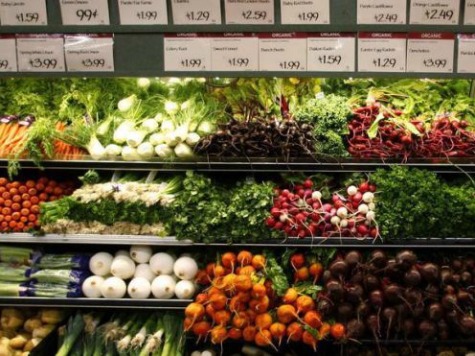
Stock markets around the world fell Thursday, led by the 246 point dive, or 1.5%, for the U.S. Dow Jones Industrial Average and a 1.9% drop for German stock market index. Analysts generally pointed to worries about shrinking Chinese lending and the potential trade war between Russia and the West, but I am more concerned that since the beginning of 2014 food prices have skyrocketed.
The Federal Reserve must be concerned that international support for “cheap money policies” to stimulate economic growth may be funding commodity speculation that is driving prices higher and creating widespread misery. If the Fed decides to raise interest rates to dampen speculation, I believe stock and commodity prices are in for a hard fall.
Margin debt on stocks is now higher than at its last peak in 2008, right before the stock and commodity markets crashed. This willingness to speculate on margin may also explain the big jump in food prices since the first of the year as shown below:
Cattle Hogs Grains Milk Coffee
+28% +25% 14% +17% +67%
Over the next couple of months, the rise in wholesale commodity prices is going to start hitting consumer pocketbooks very hard. More worrisome, the rising price action will encourage more commodity futures speculators to jump in and continue the rapid price escalation. If the Fed does not get ahead of this coming tsunami of greed, it will be in a similar situation as when food prices took off in 2008.
In April of 2008, the International Monetary Fund (IMF) warned that rising food prices could have terrible consequences for the world, including the risk of war. IMF Managing Director Dominique Strauss-Kahn called for action to keep inflation in check: “Food prices, if they go on like they are doing today… the consequences will be terrible.”
“Hundreds of thousands of people will be starving,” she said, “…(leading) to disruption of the economic environment,” especially for developing nations where the bulk of their income is spent on the bare necessities for survival.
Strauss-Kahn emphasized food inflation could destroy ten years of development progress and spark social unrest: “As we know, learning from the past, those kind of questions sometimes end in war.”
It is well known that the Great Credit Crunch of 2008 and the Great Recession that followed was caused by a build-up of speculative borrowing and investing after the 9/11 terrorist attack. What is not very well understood is that the Fed was forced to stop cutting interest rates during the financial crisis because of raging food-price inflation
The economic impacts of 9/11 threatened to drive America into a deep recession. Federal Reserve Chairman Alan Greenspan began deeply cutting interest rates on September 17, 2001, which made it increasingly cheaper to borrow money. The cheap money policy led to strong growth, especially in the interest-sensitive housing sector as Americans started taking on more and more debt and stock and commodity investors took on more leverage.
Despite inflation picking up, the Fed waited until 2004 to begin raising rates. Although the Fed moved up rates through 2005, investor frenzy continued as sub-prime lenders in 2006 actually increased the amount of money flowing to speculative investors.
As the economy slowed rapidly in mid-2007, the Fed began slowly cutting rates. After Bear Stearns filed for bankruptcy on March 31, 2008, the Fed started cutting rates faster. However, as the result of their experience with the stimulus features of 9/11 “cheap money policies,” speculators increased borrowing to buy more stocks and commodities on margin. The buying pressure sent food costs up over 30% and resulted in panic cries from the IMF and poor countries around the world for the Fed to stop driving up inflation and food prices by cutting interest rates.
From April through August the Fed held its lending rate steady. However, on September 15, 2008 the huge brokerage firm Lehman Brothers filed for bankruptcy. Over the next year, numerous financial institutions declared bankruptcy. Even major banks such as J.P. Morgan, Bank of America, and Citibank were all pushed to the brink. The cascading failures eventually culminated in the Fed’s bailout of AIG and the government’s nationalization of Fannie Mae and Freddie Mac.
There will always be international controversies that analysts try to associate with price movements in the stock markets, but seldom have international events had more than a temporary impact. The banking problems in China are significant and the Ukraine Crisis has increased international tension. However, if its “cheap money policies” are now funding speculators that are driving up food prices, the Federal Reserve is going to curb lending and drive up interest rates. Having failed to be vigilant against food inflation during the last economic crisis, the Federal Reserve may over-react this time.
The author welcomes feedback @ chriss@chrissstreetandcompany.com. Chriss Street is teaching microeconomics at University of California, Irvine this spring from March 31 – June 8, 2014. Call Student Services at (949) 824-5414 or visit http://unex.uci.edu/courses to enroll!

COMMENTS
Please let us know if you're having issues with commenting.